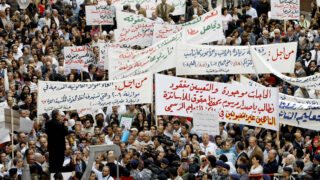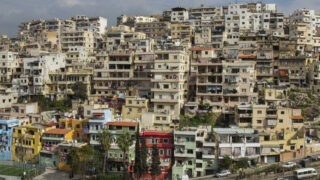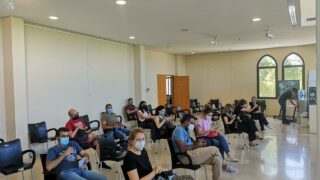
This publication has benefited from the support of the Rosa Luxemburg Foundation. This text may be reproduced in part or in full, provided the source is acknowledged.
The United Nations defines climate change as long-term shifts in temperatures and weather patterns. The negative effects of climate change are not limited to one region; they impact on the entire planet.
Lebanon’s climate trends
According to data provided by a 2019 report that was issued by the Ministry of Foreign Affairs of the Netherlands (1), Lebanon has been seeing changes in its climate trends. Since 1960, the country has registered an increase in annual mean temperature of 0.11 °C per decade and an increased the number of hot nights by 7%, especially between June and September. It recorded a decrease in rainfall of 11 mm per month on average since 1950, an increase in the amount of rainfall received during one-day extreme rainfall events, rising Mediterranean Sea levels by roughly 20 mm per year, and a 1.3°C increase in Mediterranean Sea surface water temperature since 1982.
Lebanon expects the mean annual temperature to increase by 1.2°C by mid-century and by over 2°C by 2100, a decrease in precipitation of 4 to 11% by the end of the century, a 40% reduction of the country’s snow cover with a 2°C increase in temperature, and a 70% decrease in snow cover with a 4°C increase in temperature. A decrease in snow residence time from 110 days to 45 days is also projected, while the snow that currently falls at 1,500 m might shift to 1,700 m by 2050 and 1,900 m by 2090.
Snow will melt earlier in the spring, affecting the recharge of most springs, reducing the supply of water available for irrigation during the summer, and increasing winter floods by up to 30%.
Most water resources in Lebanon come from subterranean springs and rivers. Climate change leads to a decrease in the amount of snow, consequently leading to the depletion of groundwater and water reserves.
Sea levels will rise by 30 to 60 cm in the coming 30 years. Higher sea levels will lead to seawater intrusion into aquifers, increasing the risk of coastal flooding and inundation, increasing coastal erosion, covering sand beaches, and altering coastal ecosystems in natural reserves and elsewhere.
A 2021 report by the World Health Organization (WHO) (2) stated that the percentage of hot days, whose effects have already been felt by the Lebanese, was approximately 15% of all days in the period from 1981 to 2010. Under a high emissions scenario, this percentage will reach about 65% of all days by the end of the century, and even if emissions rapidly decrease, the percentage of hot days is expected to reach about 30%. Snow will melt earlier in the spring, affecting the replenishment of most springs, reducing the supply of water available for irrigation during the summer, and increasing winter floods by up to 30%.
Most water resources in Lebanon come from ground springs and subterranean rivers. Climate change leads to a decrease in the amount of snow and consequently to a decrease in the amount of groundwater and water reserves.
Lebanon is responsible for 0.06% of global emissions. The total greenhouse emissions have increased about threefold in the country between 1994 and 2018 according to a 2021 report (3) by the Ministry of Environment and the United Nations Development Programme, with the energy sector contributing the most, at a rate ranging between 66 and 82% out of the total emissions.
Effects of climate change on Lebanese society
The effects of climate change are not expressed solely through figures and percentages. Climatic shifts also affect people’s lives and wellbeing and impact on aspects of various social and economic sectors in Lebanon.
• Public Health
Most countries have been prioritizing the health sector in their efforts to protect people from climate change effects, as it is estimated that environmental factors are responsible for the death of 15 million people worldwide annually.
In Lebanon, the WHO 2021 report asserts that the percentage of heat-related deaths among the elderly (65+ years) is approximately 2 per 100,000 population. This percentage is projected to rise to 25 per 100,000 population by 2050, while deaths due to temperature rise in Lebanon are projected to increase from 2,483 to 5,254. WHO statistics point out that 16% of deaths due to heart attacks are caused by air pollution. It also stated that Lebanon recorded 3,124 deaths from ambient air pollution in 2016.
• Food security
Climate change affects food security, and in Lebanon, agriculture is severely impacted, while limited water and land resources are increasingly threatened by population growth and urbanization. Whilst agriculture employs approximately 60% of the population, according to the WHO’s report, it contributes only around 5.5% to the GDP. Around 80% of the country’s food needs are imported. The rise in global food prices, in addition to the effect of climate change on global yields will increase the cost of obtaining food security in Lebanon. As a result of climate change, the Lebanese consumer will have to endure a 12% rise in the prices of food by 2040 and a 44% rise by 2080.
Dr. Nadim Farajalla; Program Director of the Climate Change and Environment Program at AUB's Issam Fares Institute for Public Policy and International Affairs, explains that the rise in temperature leads to an increase in agricultural expenses, a reduction in productivity, an increased need for irrigation water, and the appearance of insects and pests in various agricultural lands, thus driving the farmers to increase the use of pesticides to confront them.
Most crops will also face an increased infestation of fungi and bacterial diseases because of the rise in temperature. Crops considered particularly at risk are cherries, apples, and grapes, all of which impact the wine industry. A 2019 report by the Ministry of Foreign Affairs for the Netherlands also pointed out that the increased salinization of soil due to sea level rise will threaten banana and tomato yields in the coastal areas. The report projected a 23% reduction in maize yields in 2020, a 40% decrease by 2040, and a 64% decrease by 2080. As for the wheat crop, it was expected to be reduced by 8% in 2020, 16% by 2040, and 30% by 2080 (4).
Sea levels will continue to rise by 30 to 60 cm in the next 30 years. Higher sea levels will lead to seawater intrusion into aquifers, increasing the risk of coastal flooding and inundation, increasing coastal erosion, covering sand beaches, and altering coastal ecosystems in natural reserves and elsewhere.
On a related note, a study by the UN World Food Program and Issam Fares Institute for Public Policy and International Affairs (5) has surveyed the impact of climate change on farmers and their livelihood. It chose a sample of 22 farmers in the town of Bar Elias in the Bekaa Plain in East Lebanon for whom agricultural production is the main, and often only source of income. The results showed that 20 farmers have witnessed severe crop loss over the past ten years.
All of the surveyed farmers witnessed an increase in temperature and a decrease in rainfall over the past ten years. 18 farmers have witnessed a reduction in water availability for their agricultural production.
Fisheries, too, are struck by climate change. The fluctuations in the temperature, salinity, and acidity of seawater affect the distribution of fisheries and their characteristics. The physical properties of the seawater affect the life cycle of numerous fish, while many kinds of endemic fish are replaced by others coming from warmer waters. For example, the rise in sea temperature due to climate change has helped in facilitating the invasion of the Caulerpa taxifolia seaweed from the Red Sea to the Mediterranean, which also includes Lebanon. The rise in sea water temperature also affects the abundance of phytoplankton and, hence, the marine organisms that feed on them.
• Water security
Lebanon, like other Arab countries, faces grave challenges related to water security due to urbanization, population growth, water overexploitation, and climate change that widens the gap between supply and demand.
Farajalla says that Lebanon is affected, just like other Mediterranean countries, by climate change due to temperature rises and precipitation drops. Most water resources in Lebanon come from subterranean rivers and springs. Climate change leads to a decrease in the amount of snow and, consequently, depletes groundwater and water reserves, which negatively affects the flow of rivers and springs.
Climate change has reduced usable water supplies by 1% in 2020; the percentage will likely rise to 8% by 2040, and 29% by 2080. Drought will probably speed up the depletion of groundwater supplies, which are extracted for agricultural land irrigation.
The Atlas of Lebanon, published in 2016 (6) by the French Institute for the Near East & the National Council for Scientific Research, states that the mismanagement of water resources and the decline in groundwater supply has resulted in a sharp decrease in the abundance of wells and river flows. The mean annual flow of the Litani River, for example, has dropped from 275 million cubic meters in 1965 to 125 million in 2011.
Furthermore, Farajalla explains that climate change increases the intensity of precipitation while Lebanon’s infrastructure is unprepared to confront such challenges, which might lead to floods that jeopardize buildings and public safety. Climate change also increases the intensity of storms, and consequently the strength of the sea storms that hit the Lebanese coast, which threaten infrastructures and public safety. Signs of this have already been seen at Beirut’s coast.
• Economic sectors
The direct economic costs of climate change include a decrease in the gross domestic product (GDP) and a deceleration in economic growth, which means the depreciation of the incomes of workers and families. The Lebanese Ministry of Environment estimates this decline in GDP to reach 14% by 2040 and 32% by 2080. Vulnerable population groups, especially those living in socially and economically disadvantaged regions or in arid lands, are more susceptible to the effects of climate change.
A 2021 report by the WHO asserts that the percentage of heat-related deaths among the elderly (65+ years) in Lebanon is approximately 2 per 100,000 population. This percentage is projected to rise to 25 per 100,000 population in 2050, while deaths due to temperature rises are expected to increase from 2,483 to 5,254.
Most crops will face an increased infestation of fungi and bacterial diseases as a result of the temperature rise. Crops considered particularly at risk are cherries, apples, and grapes; all of which would impact the wine industry. The increased salinization of soil due to the rise in sea level will also threaten banana and tomato production in the coastal areas.
A guide published by the UN Environment Program and the Lebanese Ministry of Environment in 2021 (7) details the effects of climate change on all economic sectors in Lebanon. In agriculture, which occupies an area of 60% of the coastal regions including the southern plains of Saida and Sour, the rise of the sea level erodes the coastlines and allows seawater to intrude into agricultural lands. When the storms intensify, seawater covers these lands, and the winds carry the sea spray aerosol to further distances, thus salinizing fertile lands.
As for the industry, the coastal industrial establishments occupy 10% of the coastal area in regions that surround the cities of Beirut, Tripoli, Chekka, Sibleen, Choueifat, and Zouk, which are threatened by the rise in sea level.
Tourism contributes 7.6% to the GDP and employs 38% of the workforce. It is associated with the weather (sunny days and snow). These elements are affected by climate change due to the rise in temperature and the fluctuations in the rate of rainfall. 71% of the hotels and tourist resorts are located in the coastal region, especially in the cities of Beirut and Jounieh. Moreover, the erosion of the coasts is costing the resort owners additional expenses to protect them. Fishing is also affected as the storms cause damage to the fishermen's ports and inhibit marine fishery. In addition, minor fishermen face a decline in the primary marine resources and new difficult conditions.
The content of this publication is the sole responsibility of Assafir Al-Arabi and Rosa Luxemburg Foundation cannot accept any liability for it.
Translated from Arabic by Ghassan Rimlawi
Published in Assafir Al-Arabi on 03/11/2022
1- A report by the Ministry of Foreign Affairs of the Netherlands (2019), p.4 https://reliefweb.int/report/Lebanon/climate-change-profile-Lebanon
2- A report by WHO on public health and climate change in Lebanon (2021), p. 5
https://www.who.int/publications/i/item/WHO-HEP-ECH-CCH-21.01.09
3- A report by UNDP and the Lebanese Ministry of Environment (2021), p. 57
https://unfccc.int/documents/415011
4- A report by the Lebanese Ministry of Environment
https://climatechange.moe.gov.lb/viewfile.aspx?id=239
5- A report by UN World Food Program and Issam Fares Institute for Public Policy and International Affairs
https://bit.ly/3DY6dH8
6- The Atlas of Lebanon (2016), p. 110
https://books.openedition.org/ifpo/11531
7- A guide published by the UN Environment Program and the Lebanese Ministry of Environment (2021), p. 111 https://bit.ly/3FFcUPm






